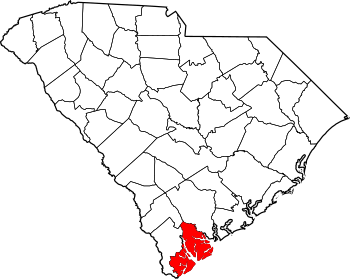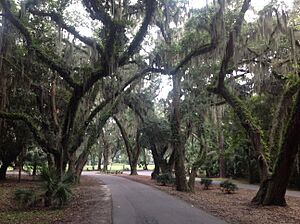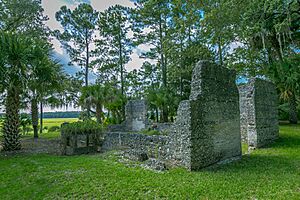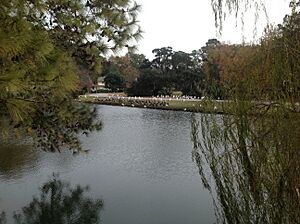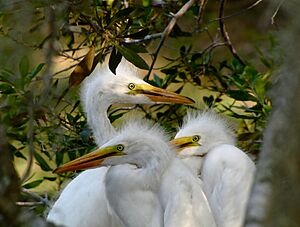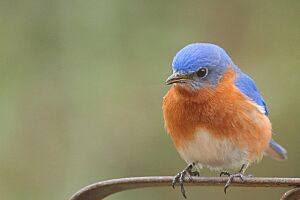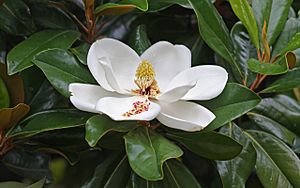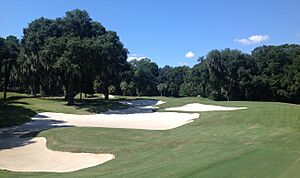Callawassie Island facts for kids
Callawassie Island is a beautiful island in Beaufort County, South Carolina. It is one of many islands found along the coast. This special island is surrounded by salt marshes and tidal creeks. It is about 17 miles (27 km) southwest of Beaufort, South Carolina. It is also about 30 miles (48 km) northeast of Savannah, Georgia.
You can reach Callawassie Island by a short causeway or by boat. The island covers 880 acres (3.6 km²) of land. It sits where several rivers and creeks meet. These include Callawassie Creek, Little Chechessee River, Okatie River, and Colleton River. The island has five miles (8 km) of waterfront along the salt marshes. It helps support the Port Royal Sound Foundation's Maritime Center.
Scientists have found that people lived on Callawassie Island about 4,000 years ago. In 1897, ancient burial mounds were discovered. More than 100 historic sites have been added to the National Register of Historic Places. The island is also home to the Callawassie Sugar Works. These are the only known sugar mill ruins in South Carolina.
In 2006, Callawassie Island became South Carolina's first Community Wildlife Habitat. This means it's a great place for animals to live. Many homes on the island are also certified as Backyard Wildlife Habitats. The island has 717 homes and home sites. Residents enjoy 33 lagoons, three parks, and a butterfly garden. There is also a 27-hole golf course, tennis courts, pools, and docks for boats.
Contents
Exploring Callawassie Island's Geography
The coastal area of South Carolina is known as the "Lowcountry". It has many sea islands and deep natural harbors. There are also winding rivers that go far inland. These areas are filled with unique plants and animals. You can find many kinds of reptiles and aquatic ecosystems here.
Callawassie Island is surrounded by other islands. Some are settled, like Spring, Lemon, and Daws Islands. Others are wild and uninhabited, such as Wim's, Crane, and Rose Islands. The waters around Callawassie include the Colleton and Okatie Rivers. There are also Little Chechessee and Callawassie Creeks.
A Look Back at Callawassie Island's History
Early Inhabitants and European Settlers
The first people lived on Callawassie Island about 4,000 years ago. The Yamasee Indians gave the island its name in the 1600s. They lived in the Lowcountry until the English arrived. Archeologists have found many items from early settlers. These include cooking tools, hunting tools, and even human remains. More than 100 historic sites have been found on the island.
Large piles of shells, called "middens," show what early tribes ate. They mostly ate shellfish. Later, European settlers built homes and farms using a material called tabby. This was a type of cement made from oyster shells. These buildings were built between the 1700s and 1850s.
European trading ships began to visit the South Carolina coast in the 1500s. They came from Spain, France, England, and the Netherlands. They traded goods and explored new lands. Many early settlements did not last. This was due to wars, conflicts with Native American tribes, and harsh environments. But new settlements always followed.
English settlers first came to Callawassie Island in 1711. For the next 120 years, the island was owned by wealthy English families. These families included the Cochrans, Heywards, Rhodes, and Hamiltons. They were important leaders and landowners in early America. The island's fertile land was used for farming and raising livestock. Later, cash crops like indigo and sea island cotton became very popular. These crops were in high demand in Europe. Farmers tried to grow sugar cane, but the climate was not right. The island's population was small, mostly owner families and enslaved people who worked the farms.
The Civil War Era and Beyond
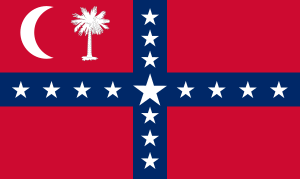
Before the Civil War, the Kirk family owned Callawassie Island. They grew rich from cotton. They also supported the Southern states that wanted to separate from the Union. In 1861, Union forces invaded the Port Royal area. They took food and livestock from many places, including Callawassie Island.
After the Civil War, the Union took control of Callawassie Island. The land was supposed to be given to freed people. However, a Union general named William Wallace Burns took ownership. He kept the island for 50 years. He hoped the area would become a major railroad and seaport hub. But this plan did not happen because other cities like Savannah and Charleston grew instead.
General Burns did not live on the island. He leased the land to local farmers. Families like the Hodges, Vaigneurs, Johnsons, and Pinckneys lived and worked there. They raised families, kept livestock, and grew crops like cotton. Life was simple but hard. People often died young from polluted water, diseases, and natural disasters. These included storms, droughts, and earthquakes.
The Great Storm of 1893
On August 27, 1893, a huge storm hit near Savannah, Georgia. It was called "The Great Storm of 1893." Callawassie Island was flooded, and crops, livestock, and buildings were destroyed. No one on the island died, but over 2,000 people in the Lowcountry lost their lives. The storm covered almost 80% of Beaufort County with water.
After the storm, a farmer named Willie Pinckney helped rebuild the farms. He was known as the "Sage of Okatie." Willie helped reduce disease by building artesian wells. These wells provided clean, unpolluted water. He continued to farm the island until 1917.
The 20th Century and Modern Times
In 1917, the boll weevil insect destroyed cotton crops in South Carolina. This ended the "King Cotton" era. A wealthy businessman from New Jersey, Benedict Kuser, bought the island. He planned to develop it for modern farming. World War I changed his plans. He built homes for sharecropper families and his own estate. Sharecroppers like the Padgetts, Bennetts, and Coolers lived and worked on the island.
Ben Kuser was also a wildlife conservationist. He brought friends to the island for hunting and fishing. Lavish parties in the 1920s stopped during the Great Depression in the 1930s. But the sharecropper families continued to thrive.
The island changed owners a few times in 1937. It ended up with the Drexel family until 1948. They sold it to timber companies. Sharecropper families continued to farm the island during this time.
Between 1948 and 1978, different businesses owned Callawassie Island. They did not develop the land. This was due to high costs, permits, and protests from local people. One big protest stopped a plan to build a road across the island. This road would have supported a large chemical plant. The protests reached the White House. People demanded protection for the local rivers, harbors, and wildlife.
In 1978, a group of investors bought the island. They later sold it to a developer. From 1981 to 2002, developers turned Callawassie Island into a private, gated community. It now has 717 home sites, 33 lagoons, and many conservation areas. It also features a golf course and other amenities. In 2002, the developer sold all the facilities to the Callawassie Island Members Club.
The Historic Callawassie Sugar Works
The Callawassie Sugar Works is a very important historical site. It has the tabby ruins of two buildings: a sugar mill base and a boiling house. There is also evidence of a third building, probably a curing shed. This complex was built around 1815–1818 to process sugar cane into sugar.
Historical records suggest the Sugar Works were part of a larger settlement. This settlement likely included housing for enslaved people and an overseer's house. The settlement was built after 1816 when James Hamilton, Jr. owned the island. The sugar mill was probably built based on designs from the West Indies.
James Hamilton, Jr., was likely the person who developed the Callawassie Sugar Works. He was the son of a major who served with General George Washington. He was also related to Thomas Lynch Jr., who signed the Declaration of Independence. Hamilton had connections in the Caribbean sugar trade. He sold the property in 1819 and moved away. The sugar works were still operating when they were abandoned.
The Callawassie Sugar Works were built based on ideas from Thomas Spalding. They had three main parts: a mill, a boiling house, and a curing shed. Today, only the foundation of the mill and parts of the boiling house remain. The boiling train bed, made of fire brick, is still there. This is where kettles were used to boil sugar.
The sugar mill ruins on Callawassie Island are special. They are called a "unique example of industrial tabby." Tabby was a building material made by mixing oyster shells, water, sand, and lime. The Spanish brought this method to the New World before 1700. Oyster shells from ancient shell mounds were a good source for tabby.
The Callawassie Sugar Works is one of the few remaining structures from early sugar production on the Atlantic Coast. In 1816, a tax on foreign sugar encouraged local sugar production. However, the climate in South Carolina was not ideal for growing sugar cane. Sugar cane needs warm temperatures and a lot of rain. The sugar works on Callawassie Island are the only example of such an early sugar business in the South Carolina Lowcountry. It was added to the National Register of Historic Places on May 27, 2014.
Callawassie Island's Amazing Nature and Wildlife
Island Environment
Callawassie Island is surrounded by a large area of salt marsh. This means the island is affected by wind and salt spray. Its plants are adapted to this maritime environment. The island has many different natural areas. These include brackish marshes, maritime forests, and salt marshes.
Much of the salt marsh around the island has two kinds of smooth spartina cord grass. This grass provides important nutrients. It makes the tidal marshes a breeding ground for many animals. These include mammals, birds, fish, and invertebrates. The area between the salt marsh and the forests has plants like bayberry, wax myrtle, and live oak.
Even though it's surrounded by salt water, Callawassie Island has 33 man-made fresh water lagoons. These lagoons cover 40 acres (0.16 km²). They provide water for the golf course. They also help the island's environment. They reduce rainwater runoff into the marsh. They also provide food for alligators and fish-eating birds.
Callawassie Island has a long history of human activity. Native Americans used the waters for fishing and the land for farming. About 275 years ago, Europeans began to change the island. They cut down most of the pine trees and farmed the land. A few old pine trees, over 150 years old, still remain.
The island has different types of forests. These include inland maritime forests and subtropical magnolia forests. There are also various kinds of hardwood forests. The maritime forest on the edge of the island has live oaks and salt-tolerant trees. These include loblolly pine and palmetto.
Many large live oaks are on the island. However, many were cut down for shipbuilding. This stopped when ironclads (metal ships) were built during the Civil War.
The most unique forest on Callawassie Island is a subtropical magnolia forest. It has many southern magnolias and white ash trees. This is the only documented forest of its kind in South Carolina. It is believed to be a very old, untouched forest. It might exist because it is on an ancient Indian shell midden. This midden is made of four feet of shells. This made the land unsuitable for farming, so it was left undisturbed.
The island's natural habitat supports a lot of wildlife. Common animals include alligators, songbirds, birds of prey, water fowl, deer, fox, possum, raccoon, mink, otters, reptiles, amphibians, and bottle-nosed dolphins.
Well-known rookeries (places where birds nest) are on two lagoons. Here, black-crowned night herons, great egrets, and great blue herons raise their young. Osprey and bald eagles also nest on the island. Many wood storks, a formerly endangered species, also live here. Other birds include doves, quail, crows, and vultures. Marshes are home to terns, gulls, sandpipers, loons, and ibis.
When the island was developed, great care was taken to protect its natural habitat. There are strict rules for landscaping to preserve the environment. A land management plan guides how common areas and open spaces are maintained. The Ecology Committee advises the Callawassie Island Property Owners Association. They help residents with environmental activities.
Wildlife Habitat Certification
In February 2006, Callawassie Island became the first community in South Carolina to be certified as a Community Wildlife Habitat. This means the community has a long-term plan to protect its wildlife and natural environment.
Callawassie residents have achieved this through the National Wildlife Federation (NWF) Backyard Wildlife Habitat program. They also provide wildlife education for everyone on the island. More than 200 properties are certified as Backyard Wildlife Habitats. This makes Callawassie Island the largest per capita Backyard Wildlife Habitat Community in America. Residents make sure their properties provide food, water, shelter, and places for young animals to grow.
The Community Wildlife Habitat certification is renewed every year. Callawassie usually earns more than 100 points each year, far more than the 40 points needed. Reports are sent to NWF each year about the island's wildlife programs.
Ecology and Wildlife Programs
Callawassie Island has many programs to support its ecology and wildlife:
- Community Ecology Guide: This guide helps new residents understand the island's unique environment. It is available on the community website.
- Wildlife Habitat Preservation Program: Areas that support wildlife are identified and maintained.
- Educational Speaker Programs: Experts talk about nature and conservation. These events happen at least four times a year.
- Save-A-Snake Program: Residents are encouraged not to harm snakes. An island herpetologist (snake expert) will move snakes from properties. They also explain how snakes help the island's environment. The slogan is: "A Live Snake is a Good Snake."
- Chinese Tallow Tree Eradication Program: Volunteers work to remove Chinese Tallow trees. These are non-native plants that can harm the local environment.
- Annual River/Marsh Cleanup Program: Volunteers clean up trash and debris from the island's shoreline.
- SCORE-SC Oyster Reef Restoration: Residents have helped build an oyster reef near the Sugar Mill Community Dock. In 2004, President George W. Bush recognized Callawassie Island for its work with this program.
- Bluebird Nest Monitoring Program: Volunteers watch over 60 bluebird houses on the golf courses. They do this during nesting season (March–August). Over 200 bluebirds fledge (leave the nest) each year. The data is sent to the Cornell Lab of Ornithology.
- Audubon Society Annual Christmas Bird Count: Every December, volunteers count bird species and individual birds on the island. They often spot over 80 species and nearly 2,000 birds. Bald eagles are often seen nesting on the island.
- Magnolia, Sequoia, and Sugar Mill Parks: The Callawassie Island Garden Club maintains these three parks. They are kept in their natural state as habitats. All three parks are next to the Okatie River and tidal creeks. Magnolia Park is special because it has a subtropical magnolia forest. This forest is unique to South Carolina.
- Annual Callawassie Island Ecology Calendar: This calendar features photos of the island's nature. Money from sales helps support ecology projects on the island.
Beautiful Gardens and Parks to Explore
Callawassie Island has three parks: Magnolia, Sequoia, and Sugar Mill. It also has a butterfly garden for everyone to enjoy. Each park offers a different experience with unique plants and views of the tidal rivers and salt marshes. These parks also show different parts of Callawassie's long history. The community wants to keep these parks as nature preserves. Only plants native to Callawassie Island can be planted there. Sequoia Park and Magnolia Park are certified as Backyard Wildlife Habitats. The Callawassie Island Property Owners Association and the Callawassie Garden Club maintain the parks and butterfly garden.
Sugar Mill Park
Sugar Mill Park is on the northwestern side of Callawassie Island. It overlooks the salt marsh and a part of the Chechessee River. A path lined with live oaks and Spanish moss leads to a community dock. Native plants in the park include southern magnolias, yaupon hollies, and sabal palms. At the back of the park are the tabby ruins of the Callawassie Sugar Works.
Magnolia Park
Magnolia Park is a one-acre subtropical magnolia forest. It is on the west side of Wild Magnolia Court. This forest is very old and has been untouched for hundreds of years. It is the only forest of its kind in South Carolina. A path goes through the park to the tidal salt marsh. You can see a part of the Colleton River from there. The park has many southern magnolias and white ash trees, which create a dense canopy. This park is also the site of an Indian shell midden. Many sabal palms and dwarf palmettos grow here, making it feel lush and tropical.
Sequoia Park
Sequoia Park is a one-acre pine forest. It is on the southwest corner of Winding Oak Drive and Sequoia Court. A path winds through many loblolly pines. It leads to a wide view of the tidal salt marsh. This is a younger forest. It grew after hardwood trees were cleared for wood or farming. Because the pine trees are tall, sunlight reaches the ground. This helps other plants grow, like oaks, sweet gum trees, and hickories.
Butterfly Garden
Callawassie's butterfly garden is on the southeast corner of Callawassie Drive and South Oak Forest Drive. It was expanded in 2010. It has colorful flowers from spring through late fall. The 6,500-square-foot (600 m²) garden has many host and nectar plants. These plants support butterflies throughout their lives. Caterpillars eat host plants like milkweed and parsley. Butterflies drink nectar from plants like butterfly bushes, zinnias, and sages. Other plants add color to attract butterflies. You can often see monarch, swallowtail, and tiger swallowtail butterflies here. In 2011, the garden was certified by the North American Butterfly Association.
Island Amenities
Besides the 27-hole golf course designed by Tom Fazio, Callawassie Island offers many other great things. The golf course was voted Best Golf Course of Bluffton in 2011. There is also a golf practice area and a pro shop. The island has a fitness center and a tennis pro shop. You can also enjoy bocce and croquet courts. The Callawassie Island and River Club Clubhouses are also available for residents.
Nearby Communities
Other communities close to Callawassie Island include Spring Island, Chechessee, Chechessee Bluff, and Heyward Point.
See also


